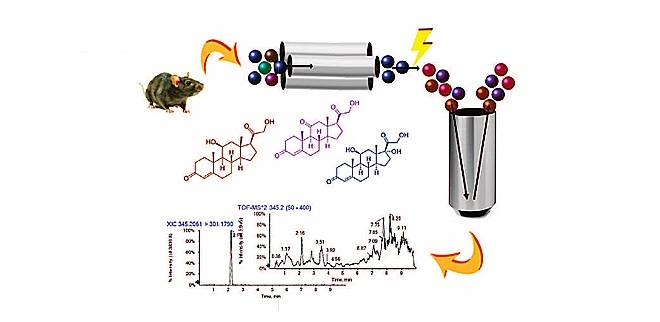

Technique developed at a Brazilian university can help understand the involvement of cortisol and other steroids in depression (image: Journal of Mass Spectrometry)
Technique developed at a Brazilian university can help understand the involvement of cortisol and other steroids in depression.
Technique developed at a Brazilian university can help understand the involvement of cortisol and other steroids in depression.

Technique developed at a Brazilian university can help understand the involvement of cortisol and other steroids in depression (image: Journal of Mass Spectrometry)
By Karina Toledo | Agência FAPESP – Patients exposed to chronic stress typically present with high blood levels of cortisol, a hormone that helps the body prepare for challenging situations, boosting heart rate and blood sugar levels, for example. Over time, this constant state of alert may contribute to the development of metabolic and psychiatric diseases.
Understanding the role of cortisol and one of its main metabolites, 11-DHC, in the development of depression is the goal of a line of research coordinated by Lúcia Helena Faccioli, Full Professor at the University of São Paulo’s Ribeirão Preto Pharmaceutical Science School (FCFRP-USP) in Brazil.
In pursuing this goal, the group has created a new method based on mass spectrometry to precisely quantify the level of six different steroid hormones in the plasma of animals and humans: cortisol, cortisone, corticosterone, progesterone, aldosterone, and 11-DHC.
“All these substances are lipidic mediators involved in various pathologies, including depression,” Faccioli told Agência FAPESP. “But to understand how all this is regulated we needed a simpler, more precise methodology to measure the levels of these hormones in both the blood and the affected tissues.”
According to Faccioli, steroid hormone levels in blood plasma are usually measured with kits containing reagents that recognize the substance of interest, but a different kit containing a specific reagent is required for each hormone.
“Cross-reactions are not uncommon in this type of test,” she said. “In addition, no methods were available to measure the metabolite 11-DHC, which is a focus for our research.”
During the postdoctoral research of Ana Paula Ferranti Peti, with FAPESP’s support, the group at FCFRP-USP developed a technique based on highâ?Âresolution multiple reaction monitoring (HR-MRM) using a mass spectrometer, a device that acts as a kind of molecular weighing scale, identifying and sorting molecules according to their mass.
“The technique we developed is capable of evaluating how compounds behave chemically and works as a form of detection in which they’re recognized by their mass and the mass of a portion of their molecule [characteristic of each compound] after undergoing a fragmentation process. The device records a signal when it recognizes the entire molecule and a fragment of it,” Peti said.
The results of the research were published in the Journal of Mass Spectrometry and selected as the cover feature.
Stress marker
To validate the new methodology, the group performed experiments with a strain of mice that is highly susceptible to stress. The animals were subjected to a protocol widely used in laboratory tests to create a chronic stress condition.
“Each day during a two-week period, the mice were subjected to an adverse situation that varied unpredictably,” Faccioli said. “On one day, they weren’t fed, on another they were deprived of water. Or the light-dark cycle was inverted, and next day they were forced to swim for a few minutes.”
As expected, the HR-MRM test showed that after 14 days, the plasma levels of corticosterone in the mice subjected to the protocol were 4.5 times higher than those in the control group, which was not stressed. Faccioli explained that corticosterone in mice serves as a stress marker just as cortisol does in humans.
Levels of 11-DHC, on the other hand, were not altered in response to the unpredictable adverse situations.
“The advantage of the new method is that besides the lipidic mediators of interest for our research, it also quantifies other steroid hormones present in the same sample,” Faccioli said. “The tool can be used by other groups interested in studying the influence of these mediators in various types of disease and infectious process.”
The article “High-resolution multiple reaction monitoring method for quantification of steroidal hormones in plasma” (doi: https://doi.org/10.1002/jms.4075) by Ana Paula Ferranti Peti, Gisele Aparecida Locachevic, Morgana Kelly Borges Prado, Luiz Alberto Beraldo de Moraes and Lúcia Helena Faccioli can be retrieved from: onlinelibrary.wiley.com/doi/abs/10.1002/jms.4075.
Republish
The Agency FAPESP licenses news via Creative Commons (CC-BY-NC-ND) so that they can be republished free of charge and in a simple way by other digital or printed vehicles. Agência FAPESP must be credited as the source of the content being republished and the name of the reporter (if any) must be attributed. Using the HMTL button below allows compliance with these rules, detailed in Digital Republishing Policy FAPESP.





